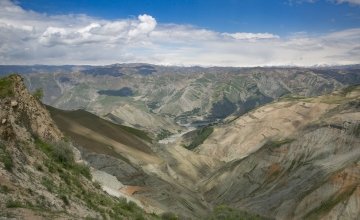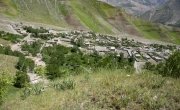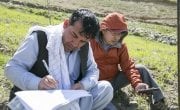
Knowledge Hub
The average temperature in Afghanistan has increased by more than 1.7°C since 1950, and it’s getting warmer. In an underdeveloped country like Afghanistan where 85% of the population rely on agriculture to survive, this can mean disastrous results for people’s ability to feed themselves and their families. But what can be done about it? This article explores a technique that is helping communities in rural Afghanistan cope with climate change and fight hunger.
As we all know, the climate emergency is upon us. The earth is warming up at such a rate that the world is facing a global crisis, jeopardising our forests, oceans, wildlife, and future as a human race. Despite this, many of us are not feeling its effect, at least not yet. However, for people living in places like northern Afghanistan, relying on reliable weather patterns and farmable land in order to survive, the effects of climate change are hitting home. Quite literally, and hard.
When mountains melt
As a direct effect of war, the natural resources in certain mountainous districts of Afghanistan have been overused, for example, through overgrazing, cutting of shrubs for fuel, and lack of soil conservation. This has led to increased occurrence of floods in the area, causing loss of lives, land and infrastructure. Moreover, vast areas of northern Afghanistan are on the move. As the glaciers of the Hindu Kush begin to disappear and the mountain snows melt faster and earlier, the people below are facing a major crisis.

The topography of Badakhshan and Takhar provinces is spectacular but exposed, thanks to the overuse of its resources, and bald hillsides like these are unable to endure the increasing annual snowmelt. Every incline is marked with the scars of erosion and below, vast rocky flood beds have formed — dry and barren during the summer months and an impassable torrent of boulders, gravel, and sediment during the spring.
These mountains are slowly disappearing.
To survive is not to live
The effects of this on communities living in Badakhshan and Takhar are immense. These melting, moving mountains destroy houses, wreck land and quash people’s means of earning a living and feeding their families. The growing season is short, winter is both long and harsh, and hunger is a constant. These provinces are no longer places to live; they are places to survive.
Concern Worldwide have been working here for 20 years, and for the past decade much of that work has involved environmental protection — or “watershed management” as the engineers like to call it.


What is a Watershed?
Think of a body of water: be it a river, a pond, a lake, a stream, or an estuary. Now think about where the water forming that river, pond or stream comes from, for example via smaller streams or rivers. The area of land that holds these smaller streams or rivers and drains (or sheds) water into a specific receiving body of water is the watershed.
- the provision of freshwater;
- the regulation of water flow;
- the maintenance of water quality;
- the provision and protection of natural resources for local livelihoods;
- protection against natural hazards (e.g. local floods and landslides);
- the provision of energy (e.g. hydropower).
However, runoff from rainwater or snowmelt can lead to significant pollution of lakes and rivers; just one of the many detrimental processes we now see exacerbated by climate change. As the Hindu Kush Mountains thaw, melted snow runs downhill, collecting sediment and other materials as it does so, and depositing them into the receiving watershed. This deterioration of watershed functions can have significant negative impacts, including the risk of increased sedimentation in water sources, an increased threat of flash flooding, reduced water quality and the depletion of soil productivity, which is disastrous for those that rely on fertile soil to grow their food.
What is watershed management?
The term ‘watershed management’ describes the process of applying water management practices to protect and improve the quality of the water and other natural resources within a watershed. Watershed management helps to control the pollution of the water and other natural resources by detecting the different kinds of pollution present, how those pollutants are transported, and recommending ways to reduce or eliminate its causes.
In Afghanistan, Concern carries out a number of watershed management techniques in some of the most affected areas such as Badakhshan and Takhar. These include measuring vital statistics, like the levels of erosion and moisture present, to understand the impact that the deterioration of the watershed has had. Additionally, we implement soil and water conservation activities to stabilise and reduce soil erosion, and to replenish the depleted water table (the upper part of the zone of saturation in a watershed).
Essentially, watershed management mitigates the risk of erosion and flooding from increased rainfall and extreme weather events (and melting mountains), and conserves the natural resources of plants, soil and existing water supply systems.





How does watershed management fight hunger?
These watershed techniques are all with the aim to further the development of the social, environmental and economic lives of communities. 85% of Afghanistan’s population rely on agriculture to survive; therefore, these techniques will also help to protect the livelihoods of the extreme poor within these communities, and build their resilience against future environmental hazards. And, ultimately, their resilience against hunger. Although this intervention requires substantial resources and is very labour-intensive, it allows communities to move closer to becoming self-sufficient, allowing them to stand on their own two feet.
The Food and Agriculture Organization of the United Nations states that watershed management contributes to the Sustainable Development Goals 6 and 15: clean, water and sanitation, and life on land. This is correct, but we must also remember that SGD 2, to end hunger, achieve food security and improved nutrition and promote sustainable agriculture, underpins 12 of the SDGs. We cannot achieve zero hunger without achieving SGD 6 and 15, and thus watershed management contributes far more to the overall goal of ‘peace and prosperity for people and the planet, now and into the future’ than initially meets the eye.
Home is earth, let’s act like it
Climate change impacts nature, and consequently human life, in ways beyond imagination. When thinking of polar ice caps - or mountains - melting, it is natural to feel sad for a loss of bio diversity, fear of rising sea levels and guilt for our role in causing this. However, climate change is already affecting agriculture, food security, and nutrition for millions of people worldwide today. And whilst we may not feel this force until it hits our home, which it inevitably will, we must remember that the earth is our home and the people living on it our neighbours.
Support how you can today:





